The Museo delle Cappelle Medicee in Florence presents a new chapter in the history of the New Sacristy, the celebrated environment that Michelangelo Buonarroti (Caprese, 1475 - Rome, 1564) designed in 1519 at the behest of Pope Leo X and through Cardinal Giulio de’ Medici: the room, which mirrors Filippo Brunelleschi’s Old Sacristy, of which it has the same layout and dimensions (albeit a totally different articulation), is located in the Basilica of San Lorenzo and was conceived by the great Tuscan sculptor to have functionallighting to give prominence to the whole structure (in particular, light comes from above through the lantern that closes the dome, and through the windows on the north, east and west sides, and the large window on the south side. The New Sacristy, left unfinished in 1534, was then resumed in 1556 (by which time Michelangelo had moved to Rome) by Giorgio Vasari (Arezzo, 1511 - Florence, 1574), who completed the layout project and arranged the tombs of Lorenzo the Magnificent and his brother Giuliano de’ Medici in the sarcophagus where he would place above it Michelangelo’s Madonna and Saints Cosmas and Damian made the former by Giovanni Angelo Montorsoli and the latter by Raffaello da Montelupo (the other tombs, that of Lorenzo duke of Urbino and Giuliano duke of Nemours, namesakes of the magnificent and respectively brother and nephew of Leo X, had been arranged by Michelangelo).
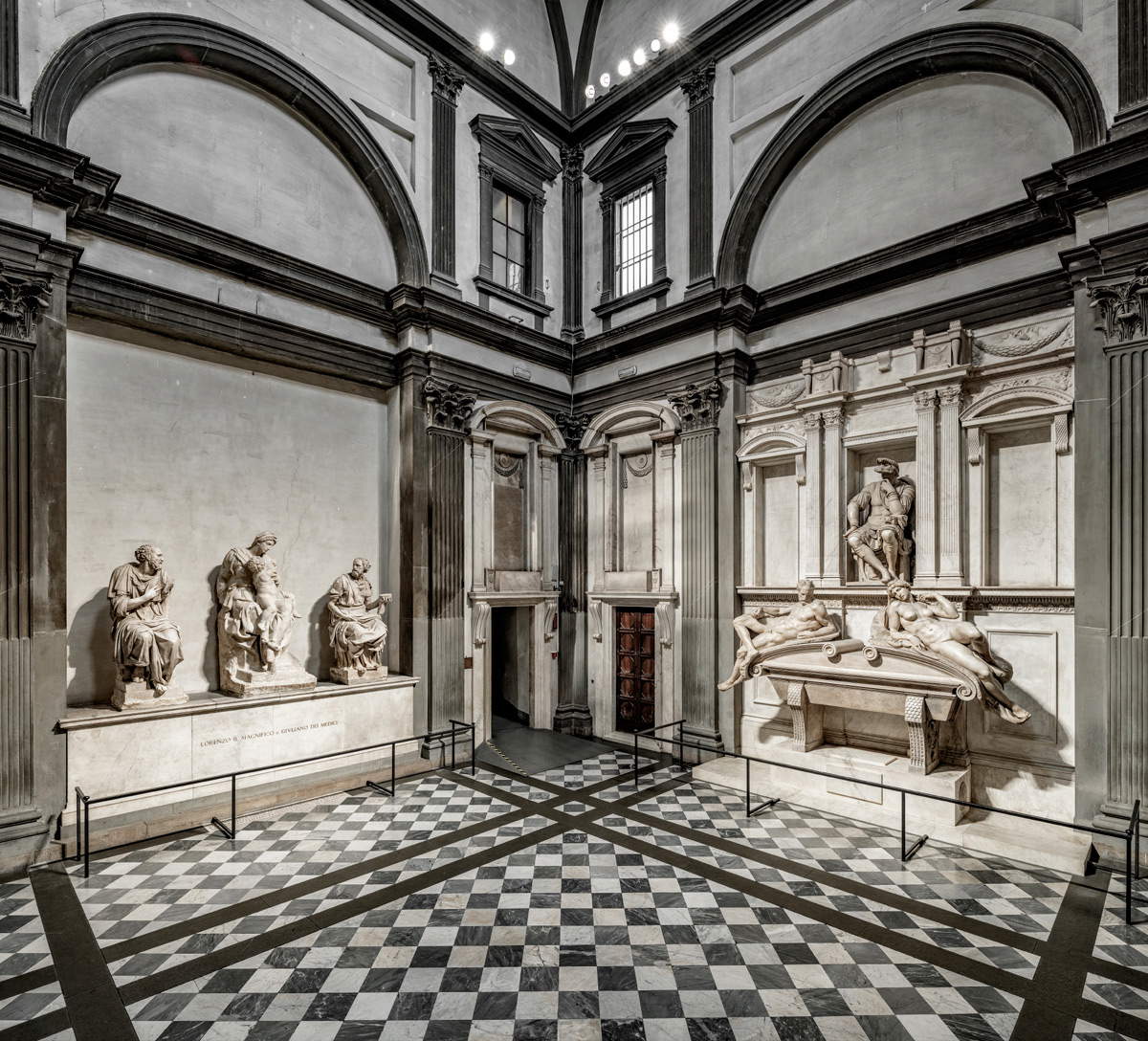 |
| Michelangelo’s New Sacristy. Ph. Credit Andrea Jemolo |
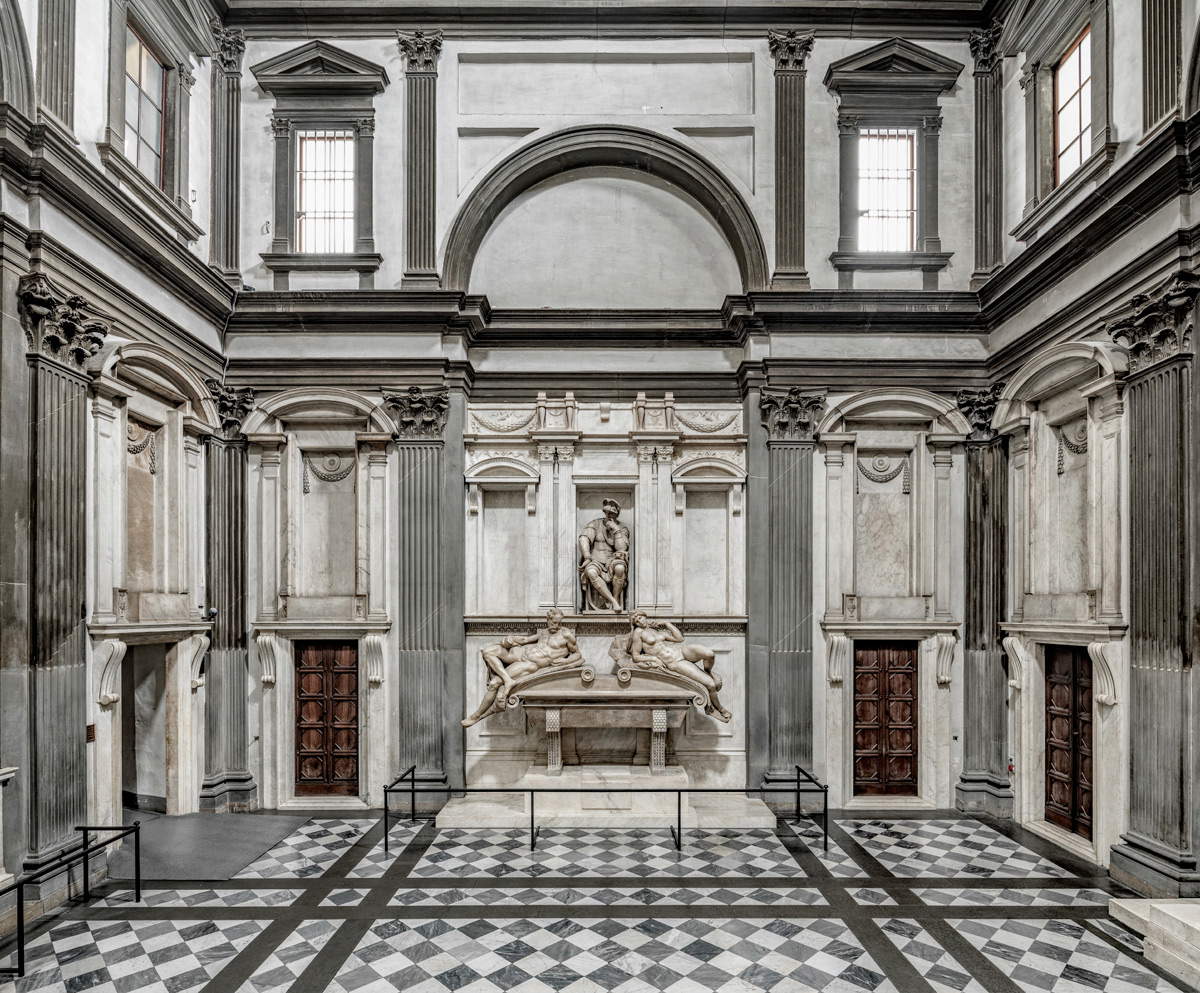 |
| The New Sacristy, seen with the tomb of Lorenzo Duke of Urbino. Ph. Credit Andrea Jemolo |
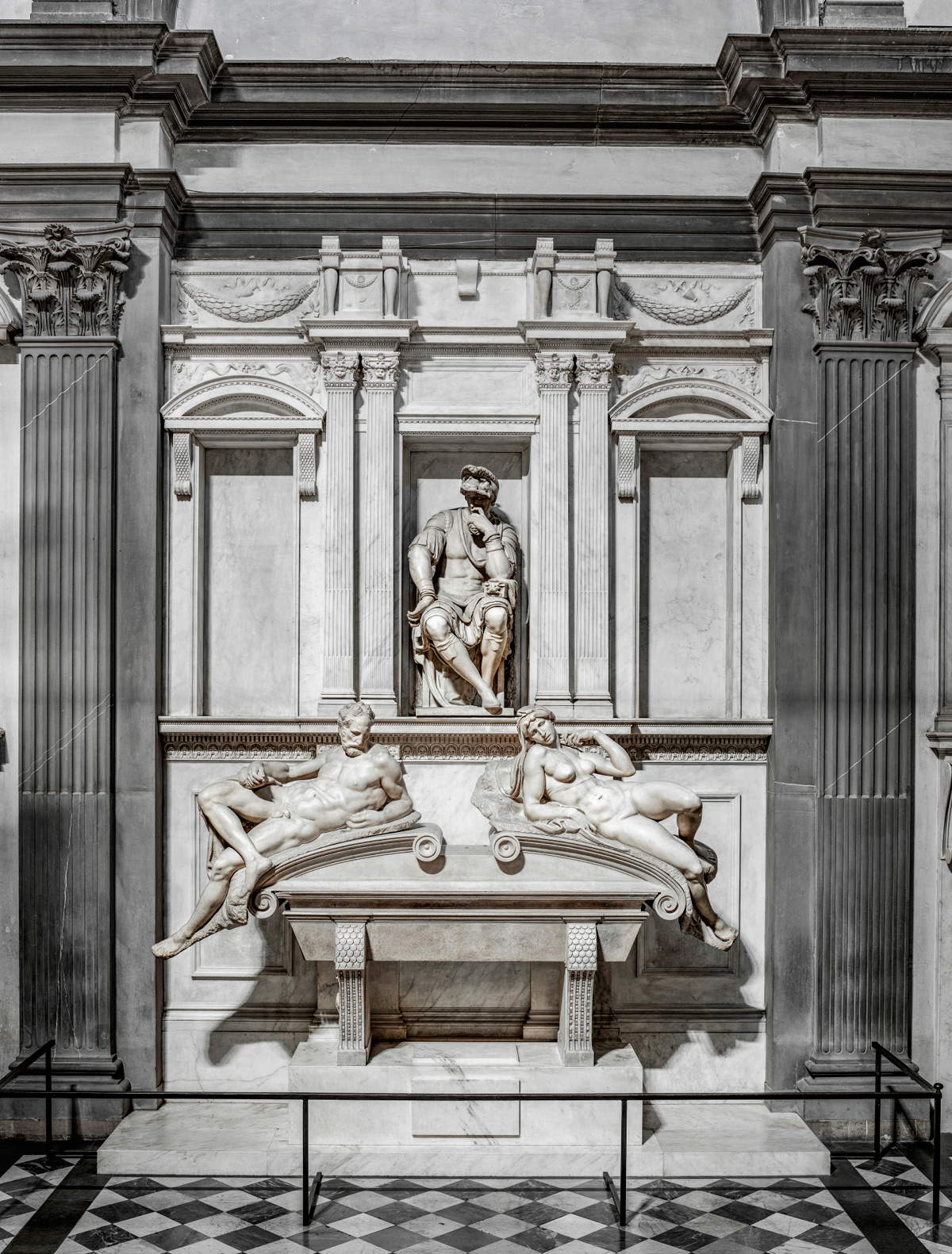 |
| The tomb of Lorenzo duke of Urbino. Ph. Credit Andrea Jemolo |
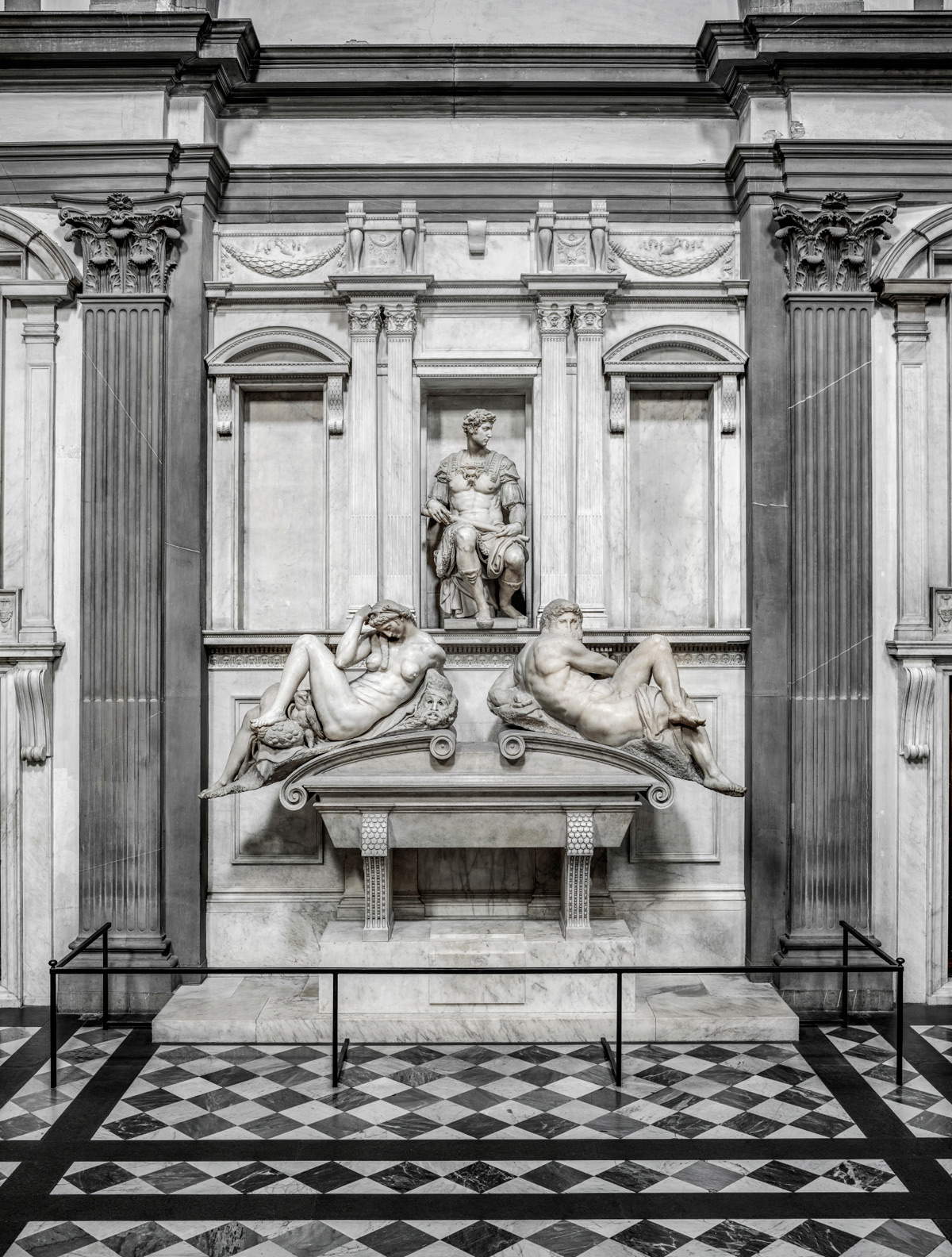 |
| The tomb of Julian duke of Nemours. Ph. Credit Andrea Jemolo |
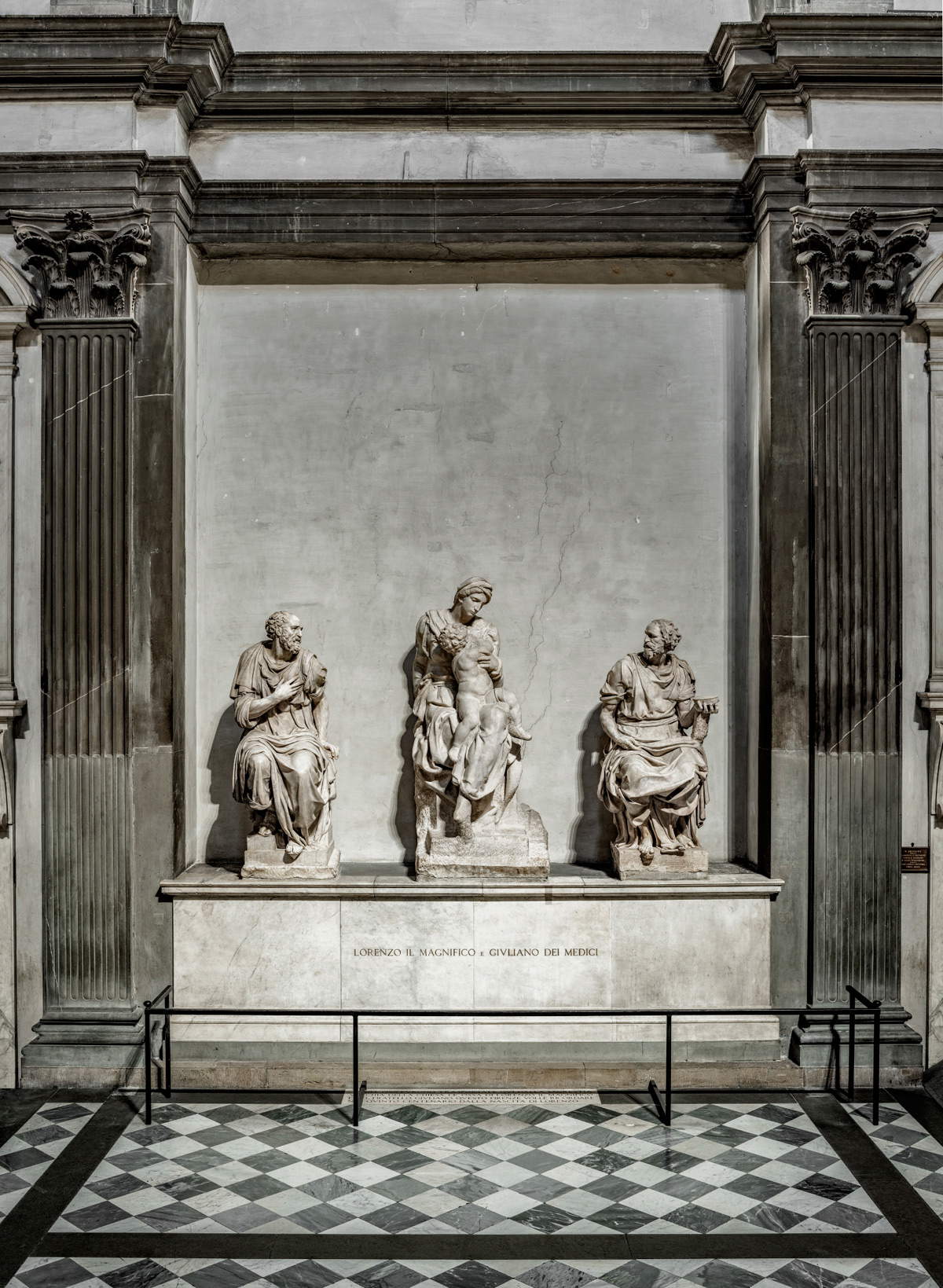 |
| The tomb of the Magnificents. Ph. Credit Andrea Jemolo |
 |
| The vault of the New Sacristy. Ph. Credit Andrea Jemolo |
Nearly five centuries later, the story of the New Sacristy continues with a lighting, maintenance and restoration project promoted by the Bargello Museums in partnership with Lottomatica, which is historically committed to the enhancement of Italy’s artistic heritage. Leading art historians have highlighted how architecture, sculpture and the use of natural light are deeply connected in Michelangelo’s art. A masterpiece of the Italian Renaissance, the New Sacristy of San Lorenzo is, as anticipated, a clear example of how the Florentine artist worked on light sources: in fact, Michelangelo designed not only the sculptural groups and decorations, but also the building, with the windows on the various architectural orders, and the lantern of the dome. Lillumination designed by Michelangelo was functional to the understanding of the symbolic and narrative path conceived by the artist himself, particularly for his splendid sculptures: but the light conditions were changed from how he had conceived them. Thus, thanks to new technologies and a skillful use of light, new lighting was created that evokes, after more than three centuries, lighting conditions close to those created by Michelangelo for the New Sacristy.
The project bears the signature of art historian and restorer Antonio Forcellino, the author of important restorations and also of well-known publications on Michelangelo, and lighting master Mario Nanni, with the collaboration of Dr. Monica Bietti, art historian in charge of the Museo delle Cappelle Medicee, and architect Maria Cristina Valenti Technical Manager of the Bargello Museums. Forcellino is also credited with the careful cleaning of the Madonna and Child and Saints Cosmas and Damian.
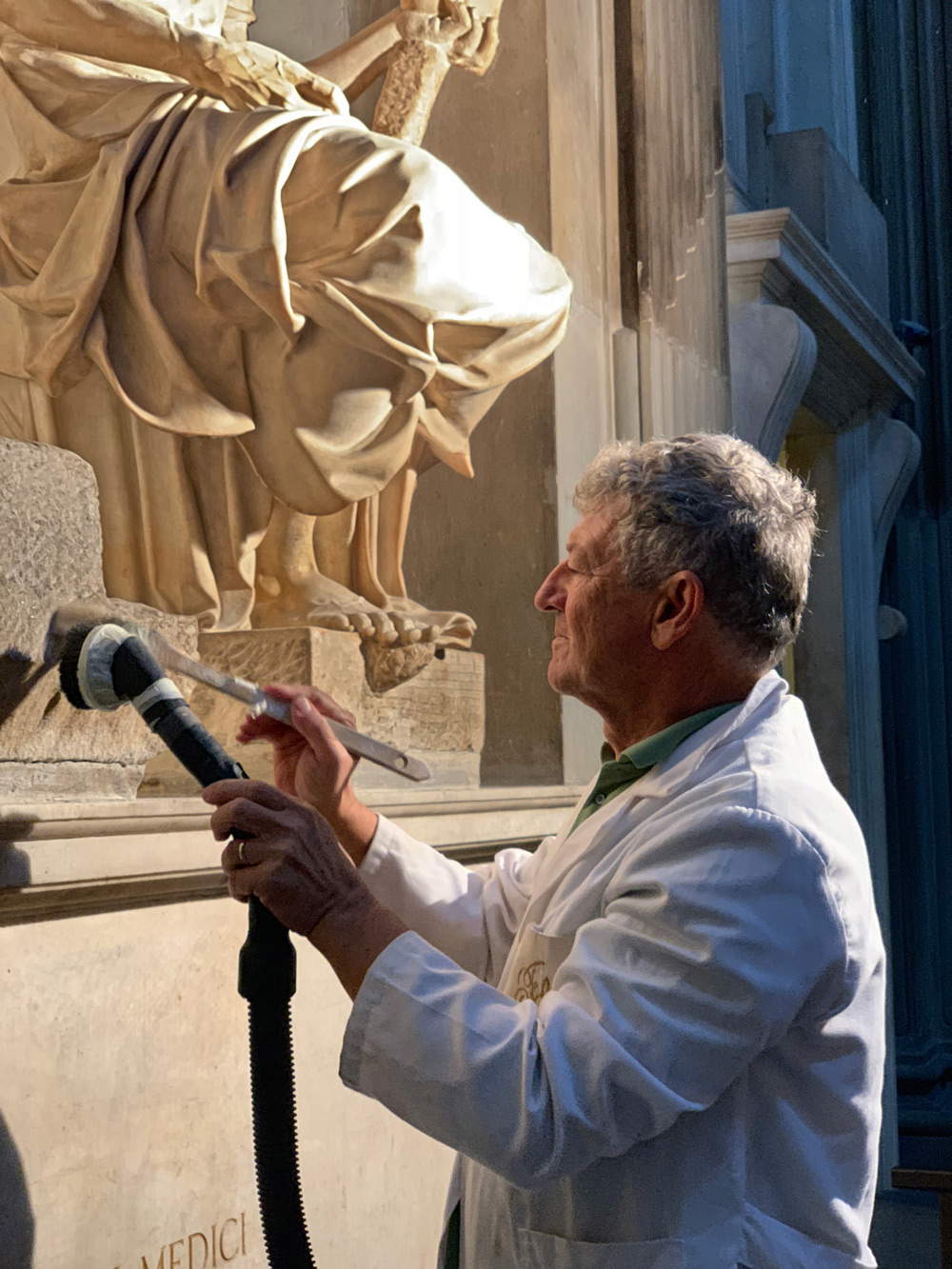 |
| Antonio Forcellino restores the Medici Madonna. Ph. Credit Andrea Jemolo |
The importance of the New Sacristy of San Lorenzo for the Italian Renaissance also lies in the uncommon characteristic of its design almost entirely by a single artist: for this reason, as mentioned above, the environment presents itself as an integrated whole of architecture, sculpture, and decoration in which light plays the role of link, commentary, symbolic path, and exaltation of pathos, as scholars such as Christoph Luitpold Frommel, Erwin Panofsky, William Wallace, and Georg Satzinger have noted. The conditions devised by Michelangelo with the opening of the windows in the upper part of the Sacristy and on all four walls produce two different qualities of light, one of which is more constant, while the other changes markedly with the passing of the hours and according to the changing seasons. A diffuse light falls from above, on the moldings, cornices and niches where horizontal shadows develop and remain constant. The plastic Lordito is always well readable, without excessive contrast, and no part of the chapel ever remains in shadow. Unillumination that, although with slight variations in intensity over time, allows the complex architecture to be read very clearly in the arc of the day.
In the New Sacristy, Michelangelo put his Roman experience to good use, recalling Bramante’s choir of St. Peter’s, Raphael’s Church of SantEligio degli Orefici, the Chigi Chapel in Santa Maria del Popolo, and above all the great oculus of the Pantheon that still gives clear and constant legibility to the architectural moldings, emphasized almost exclusively by horizontal shadows. Next to the diffuse light, there is then that produced by the windows, which, as the day goes on, in the variation of the seasons, lets in different lights that act as a commentary on the sculptural groups. This second light does not interfere too much with the diffuse one and with the legibility of the monument, but it produces two kinds of effects, one direct, the other indirect, through the marble coverings put in place by Michelangelo, which, giving rise to a series of refractions, have a very important weight in the general reading. In particular, a variety of what in technical jargon are called secondary sources are produced, which are difficult to imagine without objective measurements (time lapse). The result is the indirect irradiation of the statues, as occurs in that of Night, which during certain hours is illuminated from below, thanks to refraction on the lower right marble facing of the east wall. More generally, one can see how the course of the sun’s rays, through the windows and lantern, produces extraordinary refractive effects, so that in the morning the statue of Dawn is also illuminated from behind, through reflection from the marble behind where it beats the light directly.
It seems that Michelangelo used in sculpture and architecture what Leonardo had theorized in the Treatise on Painting. In those pages the artist from Vinci had pointed out different types of light, in addition to direct light there are also, “The reverberations caused by bodies of clear quality, of plane and semi-dense surface, which, struck by the light, that, in the likeness of the leap of the ball, reverberate in the first object.” Leonardo’s ideas on reverberation or, as he called them, on “secondary lumens” or “derivatives,” were the result of his experiments on the diffusion of light. Ideas that Leonardo himself had applied to his paintings, where it is possible to see how bodies are illuminated through the reflection of materials struck by the sun’s rays. The effects theorized and applied by Leonardo in painting are transferred by Michelangelo to the plastic arts, so that the material and its deliberate differences in workmanship are closely related to illumination: in the finishing of statues, the parts where the light does not shine are left at a rougher stage, with effects of contrast and chiaroscuro, but brought to luster the others, which are not exposed to direct light but, as in Night, to a “secondary light.” With this bold innovation Michelangelo aimed to overcome some Renaissance conventions in the diatribe over the superiority of the arts. In fact, around 1492, Leonardo had attributed an essential advantage to painters: “Sculpture was second to painting because it was not able to give as the latter did lumens and shadows by the way.” A concept reiterated by Baldassarre Castiglione in 1527: “Statues lack many things that paintings do not lack, and massimamente i lumi e le ombre.” Two decades later Benedetto Varchi, in one of his lectures in 1546 overturned Leonardo’s point of view: “And if sculpture lacks the lumens and shadows, which lartefice gives, there are those and those which nature itself makes, which and which vary naturally which those of painters do not.” These are words that seem to coincide with some of the monuments created by Michelangelo where light, and its variation, play a fundamental role: the New Sacristy thus proves to be a fundamental junction for Michelangelo as architect, sculptor and, not least, painter, that is, of an artist who also works with light.
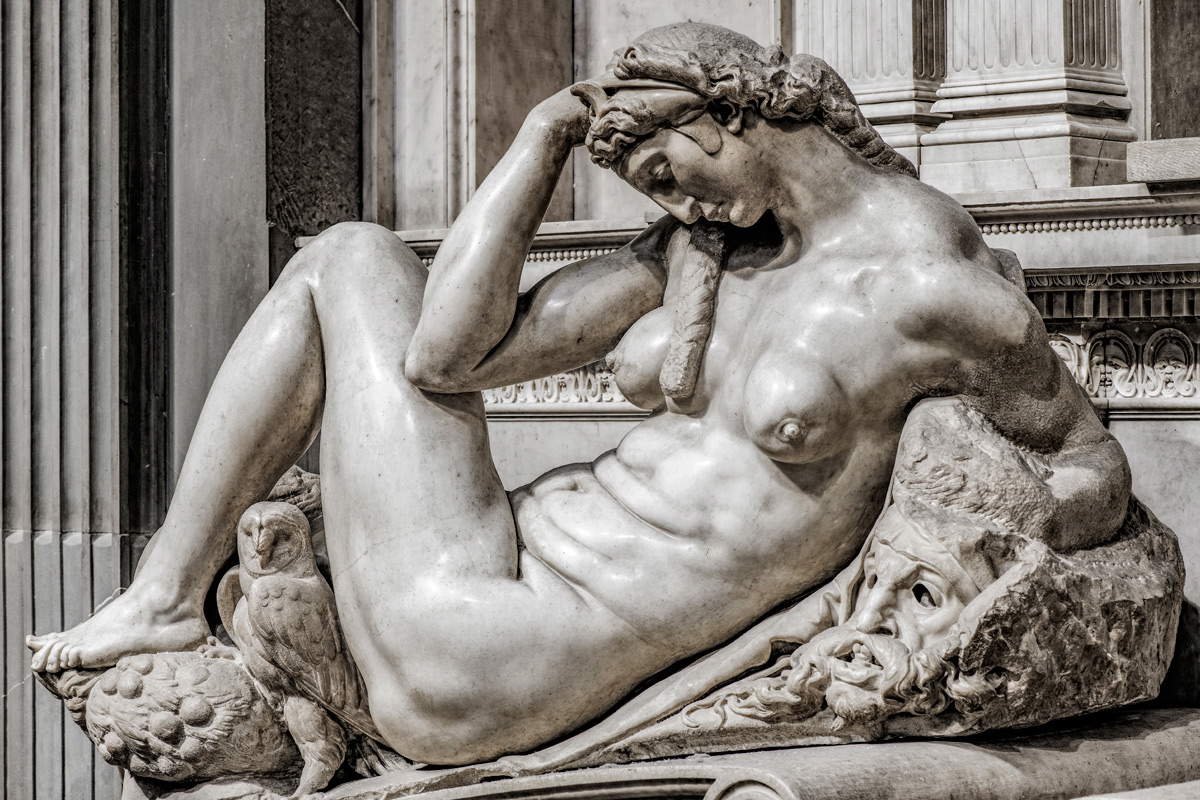 |
| Michelangelo’s Night. Ph. Credit Andrea Jemolo |
 |
| Michelangelo’s Medici Madonna. Ph. Credit Andrea Jemolo |
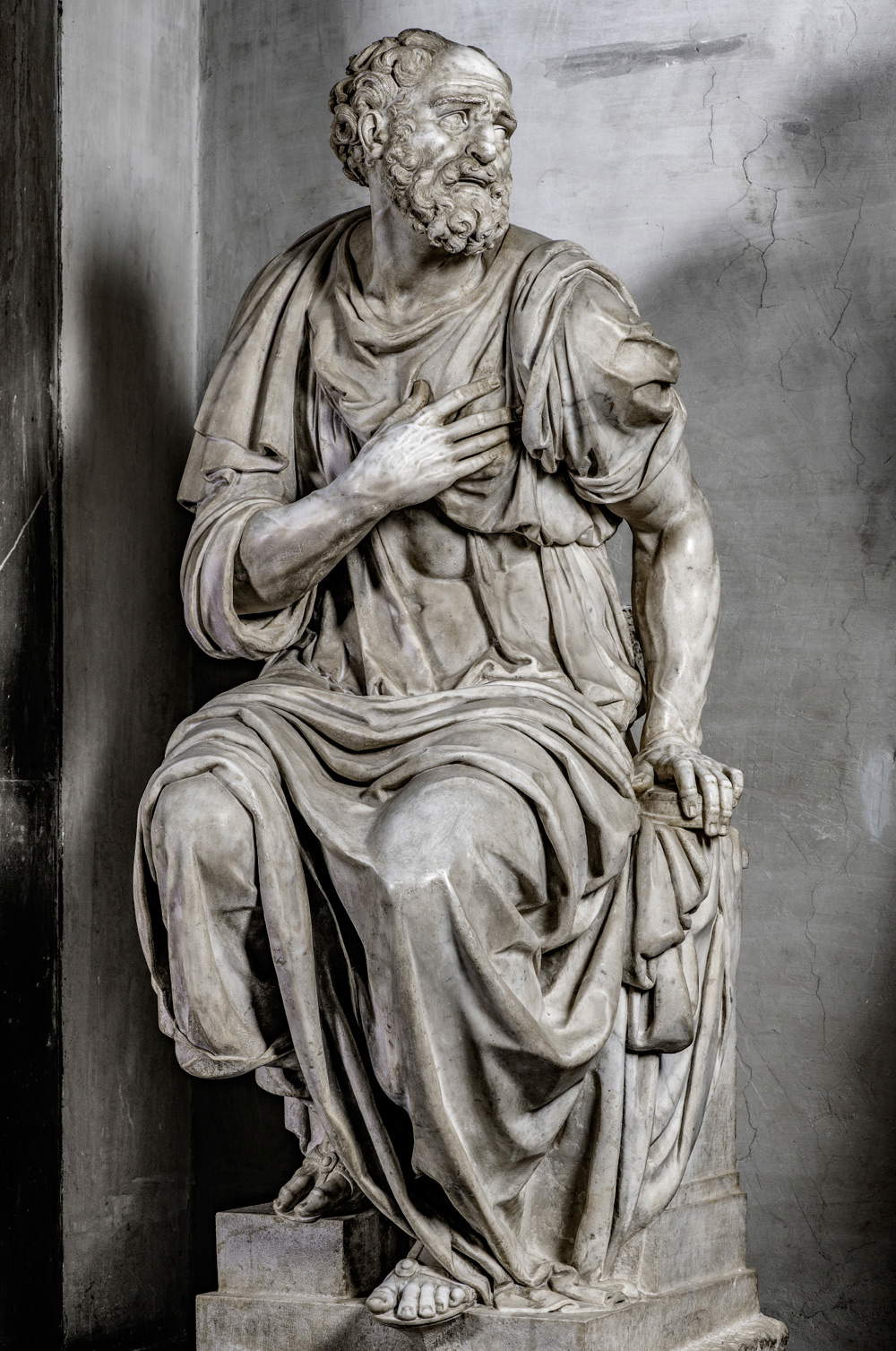 |
| Giovanni Angelo Montorsoli’s Saint Cosmas. Ph. Credit Andrea Jemolo |
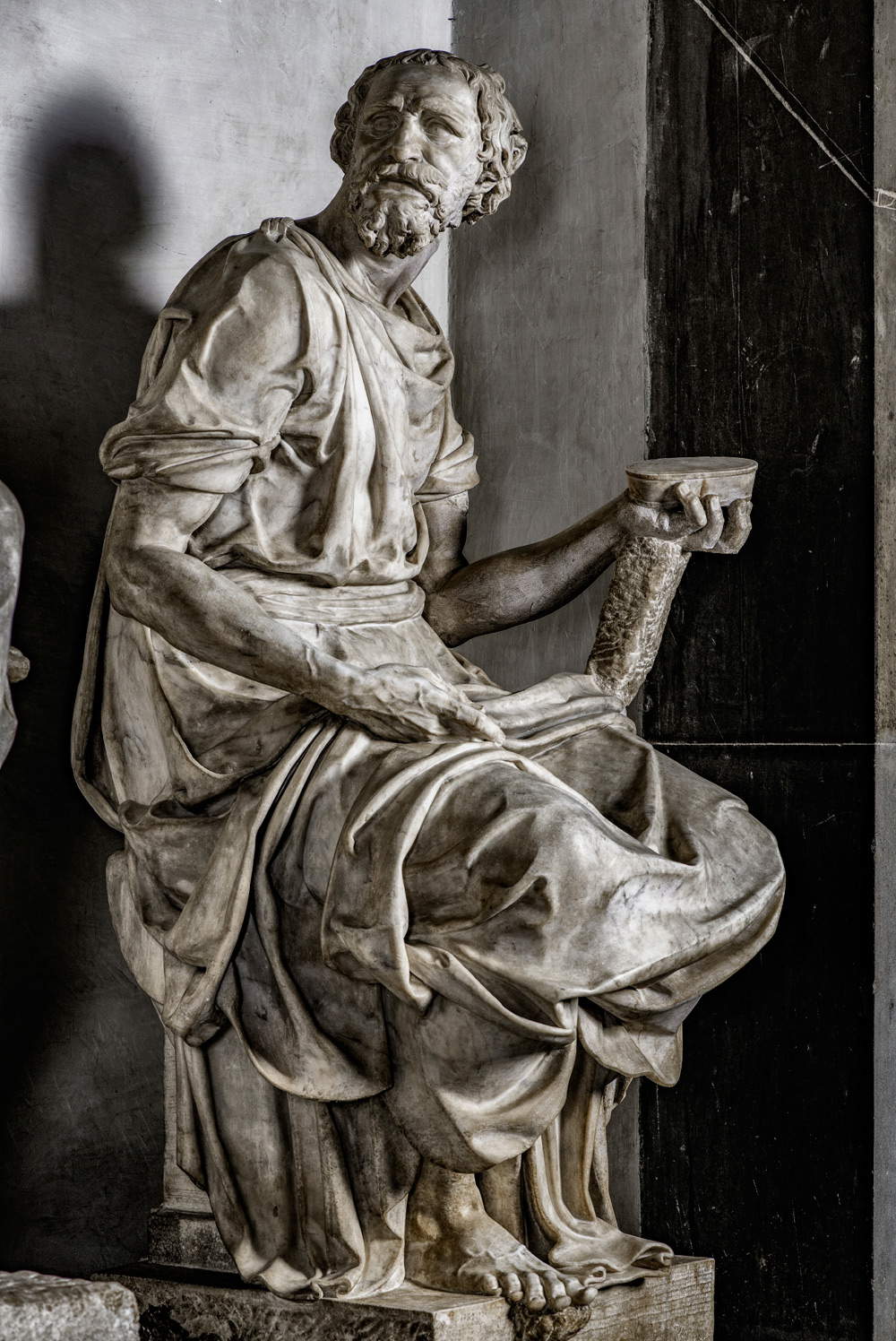 |
| Raffaello da Montelupo’s San Damiano. Ph. Credit Andrea Jemolo |
However, the marble narrative conceived and realized by Michelangelo in the New Sacristy with the passage of centuries has been altered. The construction of the Chapel of the Princes, between the 17th and 18th centuries, close to the Sacristy with its large dome intercepts for part of the year the path of the sun, attenuating the intensity of the diffused light and modifying the effects conceived by Michelangelo. The new dillumination project, without attempting a restoration of the lighting conditions prior to the construction of the Chapel of the Princes, stems from the full awareness of these conditions and attempts to recover the legibility of the artifact. In order to restore the continuity during the year of the diffused light, spotlights were placed on the cornice of the second order of the Sacristy that produce light of medium intensity. The coloring of these LED lamps was calibrated by detecting the light spectrum of the sun near the San Lorenzo complex, so as to achieve a result that conforms as closely as possible to natural light. Such lights allow the plastic articulations of the Sacristy to be read without excessive shadows while still allowing natural sunlight to act. In this way the lighting system does not interfere with indirect light or light reverberation. In certain seasons and at particular times of the day (especially in the morning), the sun’s rays enter through the large open window on the east wall and are still able to exert the extraordinary effects conceived by Michelangelo.
This is a non-invasive support to natural illumination, respecting Michelangelo’s intentions but without erasing the alterations that history has produced, with the construction of the Chapel of Princes. The study of the use of light in the Renaissance, and of the innovations made by Michelangelo has made it possible to restore to visitors and scholars a perception of the New Sacristy that is more consistent with the insights and design of the Florentine genius. It is therefore a restoration of light that does not claim to be an invasive substitute for the passage of history and the changes it brings to the work of art understood as a whole, as the modern culture of Italian conservation prescribes. A restoration of light, then, as a new frontier, which testifies to an evolution in the protection of cultural heritage: conservation and restoration are also accompanied by a philological sensitivity to the conditions of fruition and thus to the interpretation of the works of our past.
Paola DAgostino, Director of the Bargello Museums explains that “the collaboration with Lottomatica has allowed the Bargello Museums to complete a two-year project of maintenance of the Medici tombs and the realization of the new lighting in the Sacristy. The constant care and protection of works of art are primary goals of our Museums. I am also grateful to Lottomatica for also helping to devise a new lighting system for Michelangelo’s secret room, which will allow, in the future, the fascinating drawings preserved there to be safely admired.”
“We have always supported projects in the interest of the community,” said Fabio Cairoli, CEO of Lottomatica. “In every initiative we try to share and tell the values behind our idea of growth, such as technological innovation, social inclusion and cultural enhancement. Carrying out a restoration of light means developing in-depth historical and artistic research, which is possible today thanks to the most innovative lighting techniques. This is why we wanted to promote the restoration, so that Michelangelo’s wonderful work can be rediscovered in a new light.”
Warning: the translation into English of the original Italian article was created using automatic tools. We undertake to review all articles, but we do not guarantee the total absence of inaccuracies in the translation due to the program. You can find the original by clicking on the ITA button. If you find any mistake,please contact us.